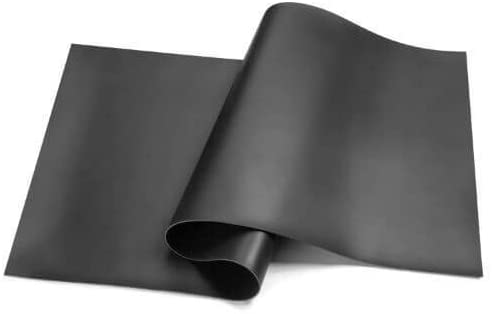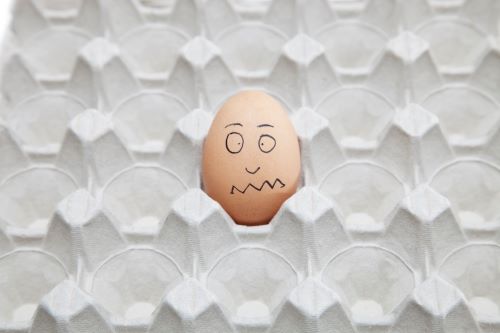Everyone who wants to soundproof a room or whole house wants to do it cheaply. Here are some of the cheapest soundproofing materials you can use. We are going to make sure that the products listed are also effective.
For real cheap soundproofing material, you can use egg cartons. To see how that works, please see our article Egg Carton Soundproofing–It Doesn’t Work. Better Alternatives Here.
 Furniture for sound reduction
Furniture for sound reduction
Soundproofing Material and Acoustic Material – Not the Same
Soundproofing material and acoustic material do not perform the same jobs. Some acoustic material will help keep some of the noise inside a room. Most of it will do nothing to keep sounds out of a room.
- Acoustic products such as foam absorbent panels or diffusers can provide great sound inside a room. For more information please see our articles, How to Sound Treat a Room, The Best Sound Diffusers, and The Best Acoustic Foam Panels.
- Soundproofing products such as Mass Loaded Vinyl and Roxul insulation can keep the noise out. For more information please see our article Roxul vs Fiberglass Insulation for Soundproofing.
7 Best Cheapest Soundproofing Materials
If you are contemplating tearing out drywall, you are not planning for cheap soundproofing. Removing drywall to insulate, or adding significantly to the wall thickness will likely be fairly expensive. Try the following soundproofing ideas first.
Cheap soundproofing options do not have to be ugly. Although some of them are. Keep in mind what the end game is.
- You want a room that is quiet enough inside to provide a peaceful place to read, watch movies/TV, or do a little gaming. By keeping noise out.
- You want a room where you can make some noise without having your family and/or the neighbors contemplating doing physical harm. By keeping sound in.
Cheap, effective soundproofing is an inexpensive way to start the process. You can find out what may work, and whether it is worth the money and hassle before committing to larger outlays of cash. For more information on DIY soundproofing options please see our article. 15 Ways of Soundproofing Existing Interior Walls Without Removing Drywall.
1) Use Furniture for Soundproofing
 Bookshelves
Bookshelves
As far as cheap soundproofing goes, this is one of the best. Unless you use it as an excuse to put a large skid mark on your credit card. Soft material will absorb sound frequencies–created inside the room and incoming noise. Harder material will add mass to the walls–preventing sound transmission.
- Bookcases. Especially tall ones are an excellent soundproofing addition to any wall. They add mass and can be very attractive. Bookcases and books can be very inexpensive at garage sales. Or if you have access to some wood, you can build your own. (Before buying wood today, check the prices. Our bookcases consist of a few hundred feet of 1 x 8 clear fir and 4 x 4 clear cedar blocks. I would hate to buy that now.)
- Full Wall Entertainment Center. Only if you already own it. Otherwise, cheap is out the window. These units are usually manufactured using MDF. MDF is great for adding mass to a wall. Quite often people set books and other heavy things on the shelves and in the cabinets–adding to the mass.
- Any Soft Furniture. All soft items in the room will absorb sound–chairs, chesterfields, cushions, blankets, duvets. (Use items you already own. Getting used furniture could be an invitation to unwanted pests.)
- Soft Wall Hangings. Soft pictures or designs, large God’s Eyes, knitted or crocheted pictures, black light Elvis velour wall hangings (from a hippie garage sale), anything soft you can hang on the wall that does not cost an arm and leg. All of these will absorb noise.
2) Hang Soundproof Blankets on the Walls
When you Google soundproof blankets, you will almost invariably find moving blankets. Most moving blankets have a soft polyester or cotton filling that works great for absorbing and dampening sound. You should be able to find them in batches of 12, making them fairly inexpensive.
They are simple to take down if, and when, you move. Or if you decide to change your soundproofing. And if you used removable hooks, you will not even damage the walls.
Soundproof blankets are relatively easy to hang on your walls. Look for some that are 8′ tall and have grommets. These should cover an 8′ high wall. Make sure your blankets touch the floor. Noise can come through even the smallest gaps–especially around windows and doors.
Although very inexpensive, easy to hang, and effective, keep in mind that most moving blankets offer black as a color option. You will find blue and particularly hideous orange and green if you look around.
Please see our articles Moving Blankets for Soundproofing Rooms and Soundproof Blankets for Windows.
3) Use Soundproof Curtains
Depending on your priorities, soundproof curtains have 2 advantages or disadvantages over soundproof blankets. They provide many color options and are more expensive. Noise cancelling and blackout curtains are also available in various sizes. You should be able to find full-length curtains to cover entire 8′ high walls.
The curtains are easy to hang on curtain rods or from removable hooks. I recommend using hooks for a couple of reasons. Curtain rods are way more expensive than hooks. More importantly, rods will hang your curtains in a pleated design that will allow noise to escape at the pleats. Using hooks allows you to get your curtains very tight to the wall.
Give some consideration to combining soundproof blankets with soundproof curtains. Blankets for flat wall areas and curtains for windows and doors. Curtains on windows and doors allow easier access for light, fresh air, and entry and exit.
4) Seal All the Cracks and Gaps
Noise will travel anywhere that air can travel. In addition to using some of these cheap soundproofing ideas, make sure that you seal the room to the best of your ability. (Up to 50% of the noise entering or leaving a room can pass through the gap under the door.)
When sealing gaps and cracks in locations that will be covered or hidden, use acoustic caulking. It is a better product for soundproofing, but it never dries and cannot be painted. When caulking around any exposed area, use a good paintable caulking. Most paintable caulking will be paint-ready within 24 hours or less.
Seal the Doors
Doors quite often let in, or out, more noise than all of the walls combined. You need to pay special attention to soundproofing it. Install self-sticking compression weatherstrip on the door jamb for the slab to seal against. (Note: You may have to adjust the door hinges and strike to allow it to close against the extra thickness of foam.
Install an adjustable sweep on the bottom of the door to seal the gap between door slab and floor. These gaps can be between 1/8″ and 1 1/2″ wide. Of the many sweeps available, try to get a cloth wrapped double foam noodle one. They seal better, are self-adjusting, and can be removed for easy cleaning. Check out our article: The Best Door Soundproof Sweep.
On most interior doors, the cavity between door jamb and the framing is left hollow and covered by casing on both sides. To complete door soundproofing, you should remove the casing from one side, spray window and door foam about 1″ thick against the remaining casing, let it dry, and fill the balance of the cavity with rockwool or fiberglass insulation. Replace the casing. Seal the casing on both sides of the door to the wall and door jamb with paintable caulking.
For much more detailed information about soundproofing interior doors, please see our article How to Soundproof a Hollow Door.
Seal the Windows
Windows rate right up there with doors for bad soundproofing. Depending on the style of window, you should be able to replace or add, weatherstrip–either compression or mohair. Your best option is to replace the existing with a new weatherstrip. Not only will this make it quieter, but it should also keep the room warmer.
If you are considering adding weatherstrip to the existing stripping, make sure the extra thickness still allows the window to open and close, and seal without binding.
Remove the window casing from inside the window frame to see what type of insulation is present between the window jamb and wall framing. If you see not much of anything, dig out what is there and spray about 1″ – 1 1/2″ of foam on the back of the brickmould or nailing fin. Fill the rest of the cavity with fiberglass or Rockwool batting. Replace the casing and caulk it to the wall and window jamb with paintable caulking.
One of the better cheap options to soundproof a window is to build a DIY window plug that fits into the frame. Window plugs soundproof the window and keep it warmer in the winter. They can easily be removed to let in light and air. For more information please see our articles How to DIY Soundproof Window Plug and How to Soundproof a Window, and The Best Soundproof Window Film.
Seal Gaps and Cracks
Cracks and gaps around windows and doors are the most obvious places for noise to pass through. But here are a few stealth openings that will allow noise penetration.
Electrical Outlets
Remove plug and switch covers, and fixtures, fill gaps between drywall and electrical boxes with acoustic caulking. Install wall plate insulation gaskets and replace the covers and fixtures.
Wall Penetrations
Holes cut for plumbing and venting are invariably too big, and rarely sealed properly. Fill the gaps with paintable caulking. If the gaps are too big to caulk comfortably, fill them with backing rod or spray foam first, then caulk them. If they are way too big for caulking–even with backing–you will have to design a cover that fits tight to the pipe. Then caulk it to the pipe.
HVAC Vents
HVAC pipes and vents can penetrate floors, walls, and ceilings. Bringing noise with them. Like plumbing penetrations, holes for HVAC piping and grills will be bigger than necessary to allow for ease of installation. To get them sealed, you will need to remove the covers and use acoustic caulking to fill the gap around the pipes. If the holes are too big, use backer rod or spray foam to fill the gap between the pipe and drywall. Then use the appropriate type of caulking to finish sealing around the pipe.
Sill Plate
The sill plate can develop gaps between it and the floor it is sitting on. (The subfloor can expand and warp away from the sill plate–leaving a gap for noise. The best cure for this is to remove all of the baseboard inside your room. Then use acoustic caulking to seal between the subfloor and sill plate. Replace the baseboard and caulk it to the wall. You can eliminate removing the baseboard by caulking it to the wall and floor. This is not an option if the flooring is carpet.
You can also have noise coming through the HVAC vents–usually caused by motors, pipe expansion, filter problems, etc. You can reduce a lot of this noise by setting furniture over, or in front of, vents. Make sure you allow at least 2 inches of clearance to allow free air flow. If the vents are high in the wall hang something soft in front of them–but not tight to the wall. The air still has to move for the equipment to operate properly and not be damaged.
Miscellaneous Cracks
As houses settle, they may develop cracks between walls and ceiling, or even in the mortar of concrete block or brick walls. These cracks also require sealing to eliminate noise pollution. Small cracks–usually up to 1/4″–in drywall can be sealed with paintable caulking or spackle. Anything wider than that will probably require drywall tape and mud. Cracks in masonry can be sealed with ordinary caulking, but using a caulking specially formulated for masonry will work better. Note: If your cracks are bigger then 1/4″ or quite long, have a professional look at the problem.
Note #1: Most interior walls have no insulation to help deaden sound. So any wall penetrations will be extra noisy.
Note #2: When using spray foam as a backer for caulking, make sure you let it dry for 24 hour, then cut off excess, and paint.
5) Mass Loaded Vinyl
 Mass Loaded Vinyl
Mass Loaded Vinyl
Mass Loaded Vinyl has an STC rating of 23 making it very effective at keeping noise outside a room and/or sound inside a room. Most MLV is black, but it can be painted any color using latex paint.
The best method of hanging MLV and having a decent-looking room is to remove the baseboard and hang the first row of MLV horizontally–nailing on each stud 1″ from the top. Cover the rest of the wall in the same manner–only nailing within 1″ of top and bottom. You should then be able to cover your rows of nails and the seams with 1 x 4 wood. Pull the bottom row snug to the floor and re-install your baseboard to hold the MLV in place. Then paint the entire room.
Please see our article Excellent Soundproofing Alternatives to Mass Loaded Vinyl for additional options.
6) Floor Underlayment
Hard uninsulated floors let a lot of sound pass through them and then bounce around creating echoes. One of the best ways to quiet down a room is by using carpet. With a good heavy underlayment. A heavy wool rug is best for sound abatement, but even a cheap rug with a good soundproofing underlayment will work well. Rug and underlayment can be put down over any surface–including another rug.
If you are considering laminate flooring, make sure you use a good laminate/hardwood underlayment. If you already have ‘click together’ laminate that is not nailed or glued down, you can pull up the flooring, put down the underlayment, and re-install the flooring.
For more information please see our article Best Soundproof Underlayment.
7) Anti Vibration Mats or Pads
Anti-vibration mats or pads are not going to stop any noise from coming into your room. But they are great at preventing vibration and noise from passing into other rooms. Individual machine mats such as treadmill mats prevent machine noise from passing into the room below. They also reduce flanking noise from passing horizontally through the floor framing members into adjoining rooms.
Smaller individual pads such as those made for washing machines and furniture are very good at reducing vibrations and all but eliminating machines or furniture moving across the floor. Noisily.
If this room is a home theater, give some serious consideration to Studio Monitor Isolation Pads to place under speakers and other sound equipment. These will also help keep the sound inside the room and prevent bass vibration from annoying the neighbors.
Please see our article The Best Treadmill Mat for Noise Reduction of 2023.
Excellent But Not so Cheap Soundproofing Materials
The following list of soundproofing materials is a step up from the above cheap list–both in cost and performance. We have included them to present more options if the list of cheap products does not meet your needs.
- Add Mass. When it comes to any type of soundproofing, mass is always your best friend. Adding mass to walls usually includes at least one more layer of 5/8″ drywall–regular or QuietRock. Drywall itself is not expensive at around $.60 cents per square foot of covered area. It is the cost of extras such as mud and tape, paint, electrical box extenders, and jamb extenders plus the added labor drives up the cost.
- Add Green Glue. For even better wall soundproofing, use Green Glue sandwiched between layers of drywall. Green Glue dissipates sound waves by turning them into non-dangerous heat before they can pass through walls. This is an excellent way of soundproofing. But be aware that it has all of the costs of just adding drywall plus the cost of Green Glue.
- Isolation. Sound isolation is a method of adding a dead air space to your wall to reduce vibration and sound waves passing through. A couple of the most effective products are soundproofing isolation clips with hat channel or resilient channel between layers of drywall. You will also have to take into account the cost of finishing the drywall and extending electrical boxes and window and door jambs.
- Room-Within-a-Room. This is the most effective method of soundproofing a room. It will keep the sound you produce inside and the noise you do not want outside. But you will need deep pockets and long arms along with quite a bit of patience. Please see our article How to Build a Soundproof Room-Within-a Room.
Cheap Ineffective Soundproofing
If you have looked at a few other soundproofing sites, you will have seen Soundproof Paint as a cheap product to quiet your room. Before deciding that this is a great simple solution, consider these 3 things.
- It is more expensive than other paint.
- Painting a room takes time and effort.
- It doesn’t work.
I mentioned egg cartons earlier but it is worth repeating because you may still see them recommended.

- Not expensive but take a while to collect enough.
- Ugly as the back end of a cow–and time consuming to install.
- They do not work.

